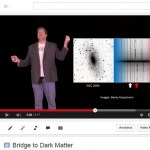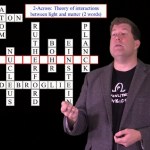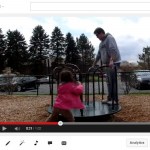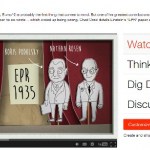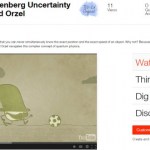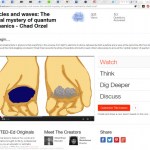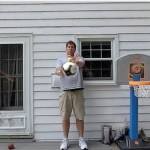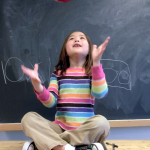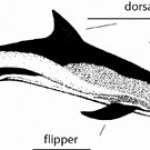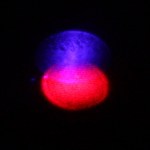Video
Back in August, I gave a talk in Stockholm at the Nordita workshop for science writers, about precision measurement searches for physics beyond the Standard Model. There's now video of this online:
The video quality isn't great, but if you'd like a clearer look at the slides, I've posted them on SlideShare. The talk was divided into two parts, though the video is not:
Part 1:
High Precision, Not High Energy: Using Atomic Physics to Look Beyond the Standard Model (Part I) from Chad Orzel
Part 2:
High Precision, Not High Energy: Using Atomic Physics to Look Beyond the Standard Model (…
The first time you hear about dark matter, it sounds kind of crazy-- asserting that we're surrounded by tons of invisible stuff is usually a good way to get locked up. But the process of its discovery is surprisingly ordinary: it's just what you do when you play cards.
Here's the second green-screen video I've done to promote Eureka: Discovering Your Inner Scientist, which comes out three weeks from tomorrow (but can be pre-ordered today!). This one is about card games, modern astrophysics, and why you probbaly shouldn't play bridge against Vera Rubin:
For those who dislike video, I'll put…
My new book comes out one month from yesterday, or four weeks from tomorrow. Of course, yesterday was Sunday, and tomorrow's a federal holiday, both lousy times for promotional posts, so I'll drop this in today instead. Here's a promotional video I put together, about how the history of quantum mechanics can be compared to working a crossword puzzle:
This is basically the talk I gave at TED@NYC last year, done in front of a green screen with slides edited in behind me for that An Inconvenient Truth vibe (Nobel committee, take note...). With some bonus cute kid photos and an explicit…
I'm teaching relativity in a course with an astronomy prefix, which means I'm obliged to talk about stars and stuff. Yesterday's lecture was about neutron stars, and how their existence was confirmed by the discovery of pulsars (with the story of Jocelyn Bell Burnell included). This requires some discussion of angular momentum to explain how something that big ends up spinning that fast (cribbing a bit from these online notes), so I needed a good demonstration of angular momentum. Which is when I remembered this 2013 post with SteelyKid on the playground, where I estimated the mass of the…
The fourth video I wrote for TED-Ed is now live: Einstein's Brilliant Mistake: Entangled States. The title is not just an Elvis Costello reference, but gets at the fact that while the Einstein, Podolsky, and Rosen paper was wrong in that the local hidden variable theories they favored are impossible, it turned out to be important and productive.
As with the others, I'm very happy with the way this came out. The images are great, and I'm glad to get in the point that Bell's key insight involves measuring different properties for the two particles, which is sometimes glossed over. It was…
I have. So I surfed the web and found this neat video from Smithsonian that explains it all.
The third of the videos I wrote for TED-Ed is now live: Schrödinger's Cat: A Thought Experiment in Quantum Mechanics.This is using basically the same argument I outlined in this post, but with awesome animation courtesy of Agota Vegso. I'm impressed by how close the images that ended up in the video are to the pictures I had in my mind while I was writing it.
As I said in that old post, I dithered for a bit about whether to run with this argument, but decided I liked it enough to go ahead. You can legitimately quibble about some of the phrasing being a little too definite (or that Schrödinger…
The second one of the TED-Ed lessons I wrote about quantum physics has now been published: What Is the Heisenberg Uncertainty Principle. This is, again, very similar to stuff I've written before, specifically this old blog post and the relevant chapter of How to Teach [Quantum] Physics to Your Dog.
As usual, I tried but probably failed to do justice to other interpretations in the "Dig Deeper" references I sent; outraged Bohmians should feel free to comment either here or there with better explanations.
Again, it's really fun to see the images the animators found to put to my words. I love…
My TED@NYC adventure last fall didn't turn into an invite to the big TED meeting, but it did lead to a cool opportunity that is another of the very cool developments I've been teasing for a while now: I've written some scripts for lessons to be posted with TED-Ed. The first of these, on particle-wave duality just went live today.
The content here is very similar to my talk last fall, which is, in turn, very similar to Chapter 8 of Eureka: a historical survey of the development of quantum physics. I did the script for this, which was then turned over to professional animators, who did a great…
With the help of advice from a manicurist, Dr. Kate Mansfeld (University of Central Florida) has come up with a way to track hatchling sea turtles for the first time. After hatching, the turtles head straight for the ocean where they grow for about 10 years or so before returning to the same beach where they hatched. Until now, researchers have wondered how these juvenile turtles spent their time.
Source:
Scientific American
As noted last week, I went to SteelyKid's day camp on Tuesday to talk about being a college professor. This was a little awkward, because I was scheduled to talk to kids ranging from not-quite-three to six-and-a-bit, and really, what do they care about the daily routine of physics faculty?
So, I did a simple demo. While I got a lot of really interesting suggestions in the comments to last week's post, most of them required more props than I wanted to drag with me. And for that age, simple is often enough. So, I just did the tennis-ball-on-a-soccer-ball trick. For the benefit of readers who…
Kate's arguing a case in Connecticut today, so I was solo-parenting last night and this morning. which means that while I did manage to watch Cosmos last night, and have some thoughts about it, I don't have the time or energy to write them up this morning. As explanation, I offer this video from dinner last night, in which SteelyKid and The Pip explore subtle issues of plant biology:
As you might guess, it's very trying to deal with such sullen and mopey children all the time...
This was also on the heels of a classmate's birthday party with SteelyKid on Saturday, which was preceded by two…
Last weekend, the circus came to town, and Grandma and Grandpa came up to help us take the kids. We took SteelyKid a couple of years ago, and figured The Pip was old enough to go this time, too. Having bought tickets a couple of years ago, I got sent a pre-sale offer link, and followed that to get tickets in the front center section.
What I didn't realize was that these put us in the "Circus Celebrity" section-- when the show started, they came and gave us these ribbon things to wear, and a bit before the intermission some of the performers came over to our section, and led us out to the…
Before going to the playground Saturday to investigate non-intertial frames, SteelyKid and I went over to campus to do some experiments in relativity. Galileian relativity, that is:
What you see here is SteelyKid sitting on a rolling lab cart with a camera bolted to it. She throws a ball up in the air a couple of times with the cart at rest, then I start pushing it across the room, and she tosses the ball a few more times. You can see from the video that, other than the motion of the background, the two cases look very similar.
This is a demonstration of the principle of relativity, which…
The Schenectady JCC, where SteelyKid and The Pip go to day care, has a playground with a merry-go-round on it. How this hasn't been sued out of existence, I have no idea, but it's a great boon to a physics professor. I've used it before to talk about angular momentum, but this weekend I enlisted SteelyKid's help to make a video illustrating a different sort of physics with the merry-go-round, a camera, and a tennis ball:
As you can see in the video, when the merry-go-round isn't moving, the ball rolls straight, but when it's spinning, the ball follows a curved path. This is a striking…
Gray's paradox was originated by the zoologist James Gray in 1936 (J. Exp. Biol. 13: 192–199, 1936). The paradox questioned how a dolphin is able to swim fast (~10.1 meters per second according to his calculations) with what he saw as a limited ability to generate that much power. Therefore, he concluded that dolphins must have some mechanism or adaptation to reduce drag (Davidson College).
More recently, Dr. Frank Fish (West Chester University, Pennsylvania) was quoted in The Scientist saying, “To resolve the paradox was to assume that flow over the dolphin’s body is laminar,…
In which Rhett and I talk about Cosmos. What, you thought there would be another topic? We have contractual obligations, you know...
Okay, there were some other topics like Battlestar Galactica (both versions), why so much of what's on Discovery Channel and TLC sucks these days, the flawed astrophysics of Firefly, speculation about how those little infrared thermometers work, and why some kinds of labs are hard.
And Cosmos again. Because, really, how could we not?
In which we move out of the original trilogy, and into J.J. Abrams territory. Cue the lens flare!
This week's random assortment of topics includes travel, airports, physics models of loading and unloading planes, uses and abuses of curve fitting, odd stuff we get sent to review, and high-speed video cameras.
Miscellaneous links:
-- Rhett's Atlanta airport post.
-- The airplane loading study I was thinking of is Optimal boarding method for airline passengers, by Jason Steffen, from 2008.
--The Slo Mo Guys, Smarter Every Day, Veritasium.
--Trespassing on Einstein's Lawn by Amanda Gefter.
That'…
This year's "Flame Challenge" asks scientists to explain color in terms an 11-year-old can understand. The rules limit answers to either 300 words of text or a 6-minute video. 300 words is ridiculously short, so video is clearly the way to go. Of course, I'm not much of a video expert, but then, one of the finalists last year (when the question was "What Is Time?") was just a guy talking into a webcam, and hell, I can do better than that. So I did this:
(This is, obviously, why I was fooling around with looking at the spectrum of light from my laptop a little while back...)
The approximate…
